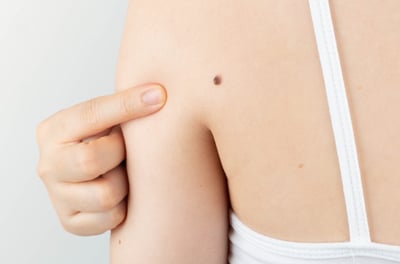
Learning that you have melanoma can be very scary. You may have left your dermatologist’s office with some handouts, but still have a lot of questions about what to expect now. Our goal is to ease your anxiety by helping you understand your condition, and what happens next. Although this type of skin cancer is the most serious, getting treatment for melanoma from the right experts increases your chances of a successful recovery.
What happens after a melanoma diagnosis?
After your initial appointment, your care team will follow up within a few days to discuss next steps. If you have not yet undergone a biopsy, that will be scheduled to determine staging, which is how far the melanoma has spread and how fast it’s growing.
If staging is already complete, you will receive a treatment plan including a surgery date and/or alternative treatments if needed.
Determining the stage of your melanoma
Using the results of your skin exam and biopsy, your dermatologist will stage your melanoma using the following guidelines:
| Stage 0 | This is the earliest stage of melanoma, also known as melanoma in situ (MIS). The cancer is only in the outer layers of the skin (the epidermis) and is highly unlikely to spread to other parts of the body. In most cases, MIS can be cured with surgery alone and life after melanoma in situ will not require further blood tests or radiology scans. |
| Stage I | Melanoma is in the outer layers of skin and in the upper part of the dermis (the inner layers). A cure is often possible. |
| Stage II | Melanoma is in the outer layers of skin and in the lower layers of the dermis. The likelihood of a cure is still very good. |
| Stage III | The cancer cells have spread beyond the skin and are found in one or more lymph nodes or lymph vessels close to where the melanoma began. Treatment will need to be aggressive, as the five-year survival rate is around 60%. |
| Stage IV | This is the most advanced melanoma diagnosis, as the cancer has spread beyond the closest lymph nodes to one or more parts of the body. Treatment will be aggressive, and survival rates are lower than with other stages. |
What to do after a melanoma diagnosis: Taking care of your biopsy site
It’s important to keep your biopsy site clean and covered to avoid infection. Make sure to follow these steps until new skin has formed over the area:
- Gently clean the biopsy site with mild soap and water once or twice daily.
- Apply an ointment such as Vaseline or Aquaphor to the site using a cotton tip applicator. It is best to use a new tub of ointment to prevent infection. Unless advised by your dermatology clinician, do NOT apply antibiotic ointment, rubbing alcohol, or hydrogen peroxide to your biopsy site.
- Cover the biopsy site loosely with gauze and gentle paper tape.
- If your biopsy requires stitches, and those stitches have been removed or have dissolved, you can stop wound care.
Biopsy sites take 1-3 weeks to heal depending upon how big the biopsy was and where on the body it was taken. Lower legs can take longer to heal. Biopsy sites may be pink when healing and then fade to skin color or lighter than skin. Contact your dermatologist if your biopsy site becomes red, swollen, and painful after the first few days,as these can be signs of infection.
What to do after a melanoma diagnosis: Getting treatment for melanoma
The goal of treatment for any stage of melanoma is to remove all of the cancer. Each patient’s treatment plan varies, so sometimes only one method of treatment is needed, while other patients need a combination of treatments.
Medication. Because melanoma can spread quickly, your doctor may recommend medication to shrink the tumor before surgery, such as chemotherapy. Medication may also be given after surgery to kill any remaining cancer cells.
Topical cream. Imiquimod is a cream that stimulates the immune system to attack abnormal cancer cells. Although it has a lower cure rate than surgery, it can be used when surgery may be dangerous or the patient is not a good surgical candidate.
Surgery. If your melanoma was detected early, surgery to remove the cancer may be the only treatment needed. Your doctor can often perform this type of surgery under local anesthesia during an office visit while you are awake.
Surgical techniques for early stages of melanoma (MIS) include:
- Standard wide local excision – used for smaller areas and those on the trunk or extremities. The excision and repair are completed on the same day.
- Staged excision – used for larger or poorly defined MIS, often on the head and neck. The excision is performed first, and the repair is not done until confirmation is received that the margins are free of MIS.
- Mohs surgery with immunostaining – this technique involves surgically removing skin cancer layer by layer and examining the tissue under a microscope until healthy, cancer-free tissue around the tumour is reached (called clear margins). Mohs surgery is used more often on non-melanoma cancers but can be used in some cases of early melanoma.
If it’s likely the cancer has spread, surgery becomes more complex. Surgical techniques for advanced stages of melanoma include:
- Lymph node biopsy – Along with removing melanoma from the skin, your doctor will remove the first lymph node to which the cancer may have spread. This is called a sentinel lymph node biopsy and will be performed in a hospital under general anesthesia.
- Regional lymphadenectomy – This involves removing most or all of the lymph nodes in the area where the cancer is located. Removing cancerous lymph nodes can prevent the melanoma from spreading to other parts of the body.
Advanced therapies
When melanoma grows deeper into the skin or spreads, it may be necessary to attack cancer cells from the inside using one of the following treatments.
- Chemotherapy – By killing cells in the body that are rapidly dividing, this drug prevents cancer from spreading. It can be administered orally, topically, or intravenously.
- Radiation therapy – This method uses high-energy rays (like X-rays), to kill cancer cells and shrink tumors.
- Immunotherapy – This treatment stimulates the immune system to recognize and fight cancer cells.
The importance of lifelong vigilance after a melanoma diagnosis
Even after getting treatment for melanoma, you are 5-10 times more likely to develop another melanoma in the future than someone who has not had it. To keep those chances as low as possible, you must take these measures to prevent skin cancer for the rest of your life:
- When you are in the sun, use SPF 30+ sunscreen, wear a wide-brimmed hat, and keep as much skin covered as possible.
- Schedule regular follow-up appointments with your dermatologist so that any new skin cancers are diagnosed early. Every 3 months is common in the beginning and may lengthen to every 6 months or once a year.
- Perform monthly self-skin checks, looking for any new or changing moles, and tell your dermatologist about them right away.
No one can understand what you are going through but you, but Forefront physicians will be with you every step of the way throughout your melanoma journey, ensuring you that you are getting the best care possible. If you are still uncertain about what’s next, please reach out to us.





